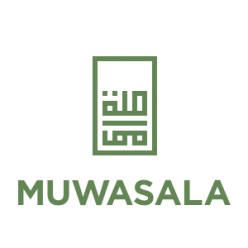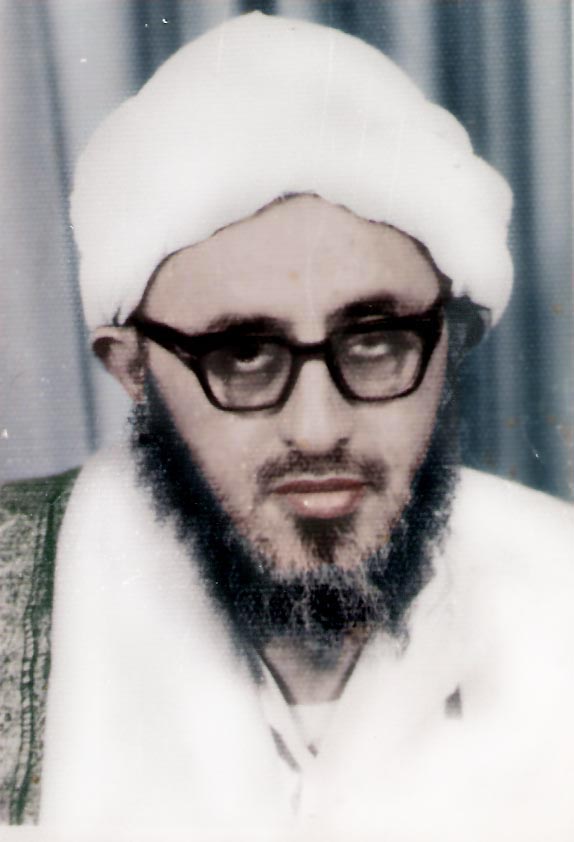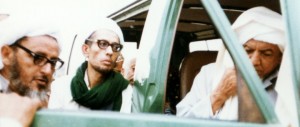His Lineage
He is al-Habib al-‘Allamah Muhammad bin Abdullah “al-Haddar” bin Shaykh bin Ahmad bin Muhsin bin Ali bin Salih bin Muhammad bin Salih bin Ahmad bin al-Husayn bin al-Shaykh al-Fakhr Abu Bakr bin Salim bin Abdullah bin Abd al-Rahman bin Abdullah bin Shaykh Abd al-Rahman al-Saqqaf bin Shaykh Muhammad Mawla al-Dawilah, bin Ali Mawla al-Darak, bin Alawi al-Ghayur, bin al-Faqih al-Muqaddam Muhammad, bin Ali, bin Muhammad Sahib Mirbat, bin Ali Khali’ Qasam, bin Alawi, bin Muhammad Sahib al-Sawma’ah, bin Alawi, bin Ubaydullah, bin al-Imam al-Muhajir il-Allah Ahmad, bin Isa, bin Muhammad al-Naqib, bin Ali al-Uraydi, bin Ja’far al-Sadiq, bin Muhammad al-Baqir, bin Ali Zayn al-Abidin, bin Husayn al-Sibt, bin Ali bin Abi Talib and Fatimah al-Zahra’, the daughter of our Master Muhammad, the Seal of the Prophets ﷺ.
His Life
Habib Muhammad was born in the village of ‘Azzah near the city of al-Bayda’ in the North of Yemen in the year 1340 (1921). His great, great grandfather Sayyid Muhsin had left Hadramawt and settled in al-Bayda’ around the beginning of the 13th Hijri century. He was given the best of upbringings by his father, who had devoted him to the service of Allah while he was still in his mother’s womb. His father hoped that Allah would in turn make him a scholar. His mother was Nur bint Abdullah Ba Sahi, an extremely pious woman known for her worship and charity. She would spend from dawn to dusk in her kitchen cooking for the hungry, especially at the time of famine in Yemen during the Second World War. In his childhood, Habib Muhammad learnt the Qur’an and the foundational Islamic sciences from his father and the scholars of al-Bayda’. In one of the last nights of Ramadan while in the mosque, he witnessed a brilliant light. When he informed his father of this, he said to him: “Perhaps it is Laylat al-Qadr, so ask Allah to make you one of the scholars that act according to their knowledge.”
His thirst for knowledge then led him to attempt to travel to Tarim at the age of seventeen. After travelling by sailboat from Aden to al-Mukalla’, he was unable to go any further due to political strife and thus returned home. Not deterred, he then travelled by land. His father accompanied him on the first leg of the journey. When the time came for them to part company his father faced the qiblah with tears in his eyes and said: “O Allah, people are sending their children to America and other places to earn them money and I am sending him to learn, so give him an opening and make him one of the scholars that act according to their knowledge.” In spite of almost dying of thirst on a mountain path between Say’un and Tarim, Habib Muhammad finally arrived safely in Tarim, and headed straight for its famous Ribat, where he was met by the director, Habib Abdullah bin Umar al-Shatiri.
Habib Muhammad spent the next four years in the Ribat in the pursuit of knowledge. His efforts were immense. He would prepare for each lesson by reading the subject material at least eighteen times and would only sleep around two hours in the day and night. So engaged was he in his studies that he did not once enter the room of the student in the room next door to him and did not open letters that were sent to him from al-Bayda’. Habib Abdullah recognized his ability and gave him special attention and responsibility, leaving the Ribat in his hands when he left Tarim. He studied at the hands of, among others, Habib Alawi bin Abdullah bin Shihab, Habib Ja’far bin Ahmad al-‘Aydarus and Shaykh Mahfuz bin Salim al-Zubaydi. After the death of Habib Abdullah in 1361 (1941), Habib Muhammad returned home, his heart full of desire to spread his knowledge and guide people to the path of Allah. In 1362 (1942), he established a school in his birthplace, ‘Azzah. He would also go out to the people, travelling from village to village reminding people of their duties. He would address the crowds that gathered for the weekly market in the city of al-Bayda’ and played an important role in resolving tribal conflicts.
He was briefly imprisoned by the British in Aden, although he had not committed any crime. When Habib Alawi bin Shihab was informed of his imprisonment he was happy as he considered it a sign of prophetic inheritance. He had previously been concerned that Habib Muhammad had met much success in calling people to Allah and had not been tested by a misfortune such as this.
He travelled on foot to perform hajj in 1365 (1945). On his return, he spent some time in Ta’izz studying at the hands of Habib Ibrahim bin ‘Aqil bin Yahya. In 1375 (1955) he performed hajj for the second time and from that year on, he would make hajj almost every year – while, at the same time, taking knowledge from the scholars of the Hijaz, among them Sayyid Alawi bin Abbas al-Maliki.
In 1370 (1950), he travelled to Somalia and was made Imam of Masjid Mirwas in Mogadishu. He remained there for a year and a half, during which time Habib Ahmad Mashhur al-Haddad visited him. He taught constantly and oversaw the establishment of a ribat in the town of Baidoa.
Many years before, Habib Abdullah bin Umar al-Shatiri had told Habib Muhammad that he would establish his own ribat in the city of al-Bayda’, and he strove to make this a reality. He sought financial support in Aden and Ethiopia, and preliminary construction was completed in 1380 (1960). Many people saw the Messenger of Allah ﷺ in their dreams giving good tidings of the success of the Ribat. Someone saw him planting his blessed foot in the Ribat saying: “This will remain as long as my Ummah remains.” Habib Muhammad was in need of a teacher so he requested that Habib Muhammad bin Salim bin Hafiz send someone from Tarim. Habib Muhammad selected Habib Zayn bin Ibrahim bin Sumayt, who became the Ribat’s greatest teacher and remained in al-Bayda’ for around twenty years. In 1402 (1981), Habib Umar bin Muhammad bin Salim bin Hafiz left a troubled Hadramawt and came to al-Bayda’. He spent ten years taking knowledge from Habib Muhammad, who married his daughter to him. Habib Umar also taught in the Ribat and expended great efforts calling the people of the region to Allah and His Messenger ﷺ. All of this was the best preparation for his return to Hadramawt after the fall of the socialist regime and his eventual establishment of his own ribat, Dar al-Mustafa.
Habib Muhammad was staunch in his opposition to the socialist government that came into power in South Yemen in 1387 (1967) which led to his imprisonment in al-Mukalla’ on a visit to Hadramawt in 1390 (1970). But this did not prevent him from calling to Allah and, in his time there, the prison was transformed. The five prayers were established in congregation and Habib Muhammad delivered lectures and lessons to the inmates. Due in part to the intercession of Habib Abd al-Qadir al-Saqqaf and Habib Ja’far al-‘Aydarus, he was eventually released and he returned to al-Bayda’. He thanked them for their efforts and warned the scholars of Tarim and Say’un of the danger of remaining in Hadramawt.
In 1395 (1974), he went to the Comoros Islands to visit Habib Umar bin Sumayt and then to Kenya to visit Habib Ahmad Mashhur al-Haddad. Habib Muhammad had established a close bond with Habib Abd al-Qadir al-Saqqaf and they travelled together to Iraq and Syria in 1396 (1975). Habib Abd al-Qadir al-Saqqaf also twice visited al-Bayda’ and Habib Muhammad’s Ribat. Habib Muhammad had great respect for the Tabligh movement and, in 1402 (1981), he headed to Pakistan, Bangladesh, Thailand and Malaysia to visit the movement’s scholars and attend their gatherings.
From the time he rose for the night prayer, his waking moments were filled with the remembrance of Allah. He would complete the recitation of the Qur’an every week. He would teach daily from books such as Sahih al-Bukhari, Ihya’ ‘Ulum al-Din, Qadi ‘Iyad’s al-Shifa and Minhaj al-Talibin of Imam al-Nawawi. He never left the congregational prayer from his childhood to his old age. He would sit daily to resolve people’s problems and receive their questions. Due to his immense legal knowledge, he was appointed mufti of the province of al-Bayda’.

He compiled a number of collections of adhkar to be read during the day and night (al-Fawa’id al-Ithna ‘Ashar, Nashi’at al-Layl) and on journeys (Jawahir al-Jawahir). The many adhkar recited today in Dar al-Mustafa are merely a selection of some of his daily awrad. He also compiled collections of adhkar and supplications for Ramadan (al-Nafahat al-Ramadaniyyah) and for hajj (Miftah al-Hajj). He wrote a treatise on the attainment of noble character (‘Ajalat al-Sibaq), a treatise on the performance of hajj (Risalat al-Hajj al-Mabrur) and compiled a selection of hadith entitled Shifa al-Saqim. Through his numerous poems, many written in colloquial Arabic, he called people to fulfill their duties towards Allah and warned them against disobeying Him.
Habib Muhammad suffered for many years from serious illness and towards the end of his life, he moved to Makkah, where the climate suited his condition. He would travel regularly to visit his grandfather, the Messenger of Allah ﷺ, where he would stand for hours in front of the Blessed Chamber. He would also go often to Jeddah to attend the gatherings of Habib Abd al-Qadir al-Saqqaf and would likewise attend the gatherings of Habib Abu Bakr al-‘Attas al-Habashi in Makkah. His son said of him that he did not waste a moment of his life. Due to his incapacity as death approached, he had one of his relatives make tayammum for him. His last words were the words he would repeat frequently throughout his life:
لا إِلَهَ إِلاّ الله أَفْنِي بِها عُمْري
لا إِلَهَ إِلاّ الله أَدْخُل بِها قَبْري
لا إِلَهَ إِلاّ الله أَخْلو بِها وَحْدي
لا إِلَهَ إِلاّ الله أَلْقى بِها رَبِّي
la ilaha ill’Allah – with it I end my life
la ilaha ill’Allah – with it I enter my grave
la ilaha ill’Allah – with it alone I isolate myself
la ilaha ill’Allah – with it I meet my Lord1
He then fell into prostration and his soul departed from his body. It was the 8th Rabi’ al-Thani 1418 (1997). As his body was carried to its resting place in the Ma’la Cemetery, Makkah was filled with the loud recitation of la ilaha ill’Allah, a fitting end to a man who had said: “Our flesh and blood is infused with la ilaha ill’Allah.” He was buried in the proximity of his mother, the Mother of the Believers, al-Sayyidah Khadijah al-Kubra and Habib Ahmad Mashhur al-Haddad. May Allah continue to benefit us by him and may his memory live on.
He would end his gatherings and prayers in the last portion of the night with these words:
وَامْنُنْ إِلَهِي بِالقَبُولِ لأعْمَالِنَا وَالدَّعَوَات ،
نَدْخُل مَعَ طَهَ وَآلِه فِي الصُّفُوفِ الأَوَّلات ،
مَعَهُمْ وَفِيهِمْ دَائِماً فِي الدَّارِ ذِه وَالآخِرَات ،
وَاغْفِرْ لِنَاظِمِهَا وَلِلْقَارِينَ هُمْ وَالقَارِيَات ،
وَمَنْ سَمِعهَا أَوْ نَشَرهَا وَكَاتِبِينَ وَكَاتِبَات ،
وَارْحَمْ وَوَفِّقْ أُمَّةَ أَحْمَد وَاهْدِ وَاصْلِحْ لِلنِّيِّات ،
عَلَيْهِ صَلَّى اللَّهُ وَسَلَّمَ عَدَّ ذَرِّ الكَائِنَات ،
وَآلِه وَكُلّ الأَنْبِيَاء وَالصَّالِحِينَ وَالصَّالِحَات ،
فِي كُلِّ لَحْظَةٍ أَبَدًا عَلَى عِدَادِ اللَّحَظَات ،
وَالحَمْدُ لِلَّهِ كَمَا يُحِبُّ عَدَّ النّعمَات ،
My Lord grant our actions and supplications acceptance
Let us enter (paradise) along with Taha and his Family in the first row
Let us be with them always in this abode and in the next
Forgive the poet and those reading this poem, male and female
And anyone who hears it and spreads it and those who write it male and female
Have mercy and grant grace to the Ummah of Ahmad, guide its members and rectify our intentions
May peace and blessings be upon him, the number of atoms in creation
And upon his Family and all the Prophets and the pious men and women
In every instant, forevermore, the sum of all innumerable moments
And all praise belongs to Allah, equal to His infinite grace and bounty, as He loves to be praised.
—
- From the `Aqidah of Shaykh Ali bin Abu Bakr al-Sakran


